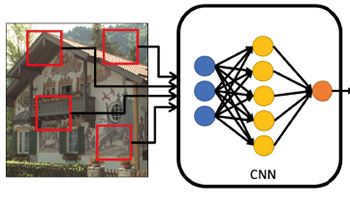References
1BarthE.WatsonA. B.2000A geometric framework for nonlinear visual codingOpt. Express7155165155–6510.1364/OE.7.000155
2BerkesP.WiskottL.2006On the analysis and interpretation of inhomogeneous quadratic forms as receptive fieldsNeural Comput.18186818951868–9510.1162/neco.2006.18.8.1868
3BergstraJ.DesjardinsG.LamblinP.BengioY.2009Quadratic polynomials learn better image featuresTech. report1337
4BiancoS.CelonaL.NapoletanoP.SchettiniR.2018On the use of deep learning for blind image quality assessmentSignal, Image Video Process.12355362355–6210.1007/s11760-017-1166-8
5BosseS.ManiryD.WiegandT.SamekW.A deep neural network for image quality assessment2016 IEEE Int’l. Conf. on Image Processing (ICIP)2016IEEEPiscataway, NJ377337773773–7
6ChengZ.TakeuchiM.KattoJ.A pre-saliency map based blind image quality assessment via convolutional neural networks2017 IEEE Int’l. Symposium on Multimedia (ISM)2017IEEEPiscataway, NJ778277–82
7ChowdhuryA. R.LinT.-Y.MajiS.Learned-MillerE.One-to-many face recognition with bilinear cnns2016 IEEE Winter Conf. on Applications of Computer Vision (WACV)2016IEEEPiscataway, NJ191–9
8DengJ.DongW.SocherR.LiL.-J.LiK.Fei-FeiL.ImageNet: A large-scale hierarchical image database2009 IEEE Conf. Comput. Vis. Pattern Recognit.2009IEEEPiscataway, NJ248255248–55
9GaoY.BeijbomO.ZhangN.DarrellT.Compact bilinear poolingProc. IEEE Conf. on Computer Vision and Pattern Recognition2016IEEEPiscataway, NJ317326317–26
10GhadiyaramD.BovikA. C.2015Massive online crowdsourced study of subjective and objective picture qualityIEEE Trans. Image Process.25372387372–8710.1109/TIP.2015.2500021
11GrüningP.MartinetzT.BarthE.
12HanD.KimJ.KimJ.Deep pyramidal residual networksProc. IEEE Conf. on Computer Vision and Pattern Recognition2017IEEEPiscataway, NJ592759355927–35
13HeK.ZhangX.RenS.SunJ.Deep residual learning for image recognitionProc. IEEE Conf. on Computer Vision and Pattern Recognition2016IEEEPiscataway, NJ770778770–8
14HuJ.ShenL.SunG.Squeeze-and-excitation networksProc. IEEE Conf. on Computer Vision and Pattern Recognition2018IEEEPiscataway, NJ713271417132–41
15HubelD. H.WieselT. N.1965Receptive fields and functional architecture in two nonstriate visual areas (18 and 19) of the catJ. Neurophysiol.28229289229–8910.1152/jn.1965.28.2.229
16HosuV.LinH.SziranyiT.SaupeD.2020KonIQ-10k: An ecologically valid database for deep learning of blind image quality assessmentIEEE Trans. Image Process.29404140564041–5610.1109/TIP.2020.2967829
17JähneB.Spatio-Temporal Image Processing: Theory and Scientific Applications1993Vol. 751SpringerBerlin
18KangL.YeP.LiY.DoermannD.Convolutional neural networks for no-reference image quality assessmentProc. IEEE Conf. on Computer Vision and Pattern Recognition2014IEEEPiscataway, NJ173317401733–40
19KimJ.ZengH.GhadiyaramD.LeeS.ZhangL.BovikA. C.2017Deep convolutional neural models for picture quality predictionIEEE Signal Process. Mag.34130141130–4110.1109/MSP.2017.2736018
20KimJ.NguyenA.-D.LeeS.2018Deep CNN-based blind image quality predictorIEEE Trans. Neural Netw. Learn. Syst.30112411–2410.1109/TNNLS.2018.2829819
21KrizhevskyA.SutskeverI.HintonG. E.2012Imagenet classification with deep convolutional neural networksAdv. Neural Inf. Process. Syst.25109711051097–105
22KrizhevskyA.NairV.HintonG.
23LarsonE. C.ChandlerD. M.2010Most apparent distortion: full-reference image quality assessment and the role of strategyJ. Electron. Imaging191100610.1117/1.3267105
24LinT.-Y.RoyChowdhuryA.MajiS.Bilinear CNN models for fine-grained visual recognitionProc. IEEE Int’l. Conf. on Computer Vision2015IEEEPiscataway, NJ144914571449–57
25LiY.WangN.LiuJ.HouX.Factorized bilinear models for image recognitionProc. IEEE Int’l. Conf. on Computer Vision2017IEEEPiscataway, NJ207920872079–87
26LiX.WangW.HuX.YangJ.Selective kernel networksProc. IEEE Conf. on Computer Vision and Pattern Recognition2019IEEEPiscataway, NJ510519510–9
27LiuX.van de WeijerJ.BagdanovA. D.Rankiqa: Learning from rankings for no-reference image quality assessmentProc. IEEE Int’l. Conf. on Computer Vision2017IEEEPiscataway, NJ104010491040–9
28MaK.LiuW.ZhangK.DuanmuZ.WangZ.ZuoW.2018End-To-end blind image quality assessment using deep neural networksIEEE Trans. Image Process.27120212131202–1310.1109/TIP.2017.2774045
29MittalA.MoorthyA. K.BovikA. C.2012No-reference image quality assessment in the spatial domainIEEE Trans. image Process.21469547084695–70810.1109/TIP.2012.2214050
30MotaC.BarthE.2000On the uniqueness of curvature featuresDynamische Perzeption9175178175–8
31PaszkeA.GrossS.MassaF.LererA.BradburyJ.ChananG.KilleenT.LinZ.GimelsheinN.AntigaL.DesmaisonA.KöpfA.YangE.DeVitoZ.RaisonM.TejaniA.ChilamkurthyS.SteinerB.FangL.BaiJ.ChintalaS.WallachH.LarochelleH.BeygelzimerA.d’Alché-BucF.FoxE.GarnettR.PyTorch: An Imperative style, high-performance deep learning libraryAdvances in Neural Information Processing Systems 322019Curran AssociatesRed Hook, NY, USA802480358024–35
32PonomarenkoN.JinL.IeremeievO.LukinV.EgiazarianK.AstolaJ.VozelB.ChehdiK.CarliM.BattistiF.KuoC.-C. J.2015Image database TID2013: Peculiarities, results and perspectivesSignal Process. Image Commun.30577757–7710.1016/j.image.2014.10.009
33PeiS. C.ChenL. H.2015Image quality assessment using human visual DOG model fused with random forestIEEE Trans. Image Process.24328232923282–9210.1109/TIP.2015.2440172
34SimonyanK.ZissermanA.
35SheikhH. R.SabirM. F.BovikA. C.2006A statistical evaluation of recent full reference image quality assessment algorithmsIEEE Trans. image Process.15344034513440–5110.1109/TIP.2006.881959
36TuZ.WangY.BirkbeckN.AdsumilliB.BovikA. C.
37UstinovaE.GaninY.LempitskyV.Multi-region bilinear convolutional neural networks for person re-identification2017 14th IEEE Int’l. Conf. on Advanced Video and Signal Based Surveillance (AVSS)2017IEEEPiscataway, NJ161–6
38VargaD.SaupeD.SzirányiT.DeepRN: A content preserving deep architecture for blind image quality assessment2018 IEEE Int’l. Conf. on Multimedia and Expo (ICME)2018IEEEPiscataway, NJ161–6
39VigE.DorrM.MartinetzT.BarthE.2012Intrinsic dimensionality predicts the saliency of natural dynamic scenesIEEE Trans. Pattern Anal. Mach. Intell.34108010911080–9110.1109/TPAMI.2011.198
40VolterraV.Theory of Functionals and of Integral and Integro-differential Equations1959Dover, New York
41WangQ.WuB.ZhuP.LiP.ZuoW.HuQ.
42YeP.KumarJ.KangL.DoermannD.Unsupervised feature learning framework for no-reference image quality assessment2012 IEEE Conf. on Computer Vision and Pattern Recognition2012IEEEPiscataway, NJ109811051098–105
43ZetzscheC.BarthE.1990Fundamental limits of linear filters in the visual processing of two-dimensional signalsVis. Res.30111111171111–710.1016/0042-6989(90)90120-A
44ZetzscheC.BarthE.Image surface predicates and the neural encoding of two-dimensional signal variationHuman Vision and Electronic Imaging: Models, Methods, and Applications1990Vol. 1249SPIEBellingham, WA160177160–77
45ZetzscheC.BarthE.WegmannB.WatsonA. B.The importance of intrinsically two-dimensional image features in biological vision and picture codingDigital Images and Human Vision1993MIT PressCambridge109138109–38
46ZhaiG.MinX.2020Perceptual image quality assessment: a surveySci. CHINA Inf. Sci.6321130110.1007/s11432-019-2757-1
47ZhangW.MaK.YanJ.DengD.WangZ.
48ZhouB.LapedrizaA.KhoslaA.OlivaA.TorralbaA.2017Places: A 10 million image database for scene recognitionIEEE Trans. Pattern Anal. Mach. Intell.40145214641452–6410.1109/TPAMI.2017.2723009
49ZoumpourlisG.DoumanoglouA.VretosN.DarasP.Non-linear convolution filters for CNN-based learningProc. IEEE Int’l. Conf. on Computer Vision2017IEEEPiscataway, NJ476147694761–9

 Find this author on Google Scholar
Find this author on Google Scholar Find this author on PubMed
Find this author on PubMed